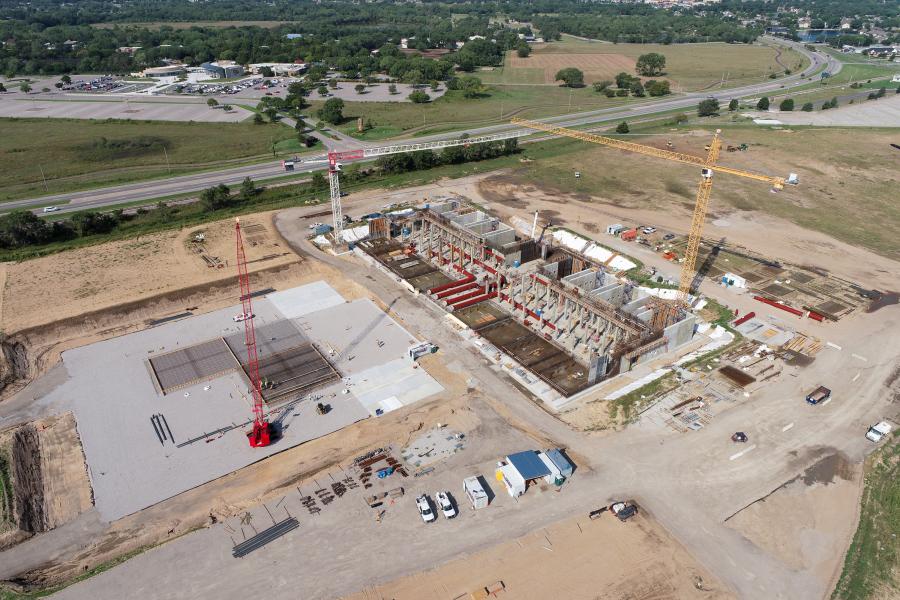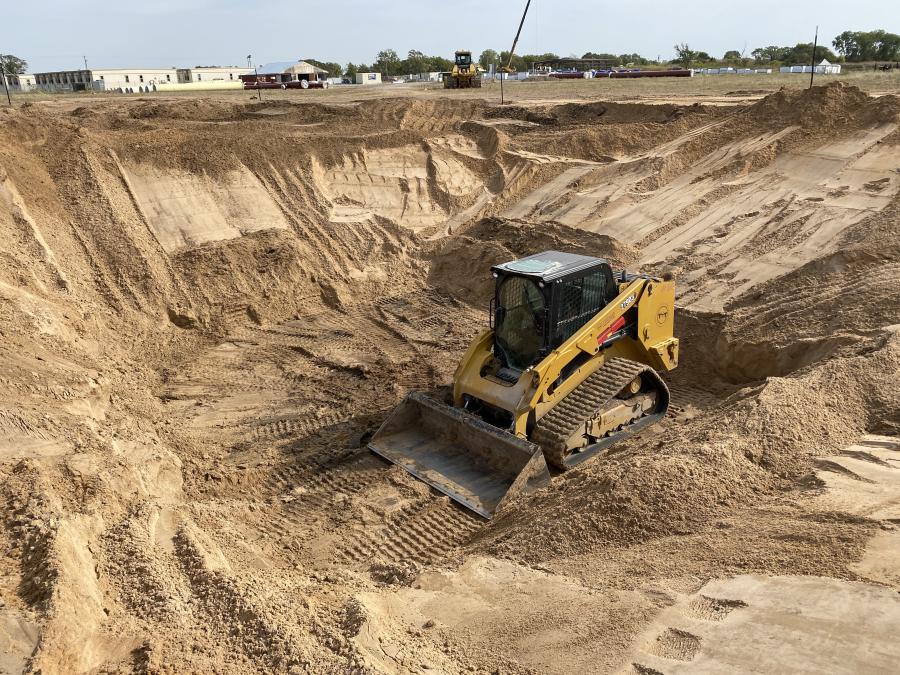Wichita Water Partners, a joint venture of Alberici and Burns & McDonnell, was awarded the $556.8 million contract for the new Wichita Northwest Water Facility.
(Wichita Water Partners photo)
Construction workers in Wichita, Kan., are working on a water treatment facility that will serve residents and area businesses for generations to come. The plant, with a 120-million gal. per day capacity, will include fully redundant treatment trains and components which will work to ensure reliable treatment, optimized maintenance and the extended useful life of the structure.
"A safe and quality water system is a vital part of Wichita's infrastructure, which serves up to 550,000 people across Wichita and surrounding communities," said Bill Perkins, city of Wichita project manager. "Our current water treatment facility is 80 years old and needs replacement. The project also represents the final investment in diversifying the city's water supply, providing flexibility to treat water from surface water, groundwater and aquifer storage and recovery sources, making the city more resilient to drought conditions."
Described as a game changer, the new Wichita Northwest Water Facility will serve residents across Wichita and surrounding communities, including Andover, Bel Aire, Benton, Derby, Kechi, Park City, Rose Hill, Valley Center, as well as some rural water districts in both Sedgwick and Butler counties. The city received a federal loan to begin construction, with rate payers reportedly saving roughly $97 million in costs.
"Like any aging asset, it requires a high level of maintenance and attention," said Perkins. "That said, a plan is in place to ensure reliable delivery of high-quality finished water to all our customers until the new plant comes online in 2024."
While the project totals $556.8 million, the design and construction of the facility is $500.2M, $14 million under the city's budget for this portion of the project. Officials entered into a contract with Wichita Water Partners, a joint venture of Alberici and Burns & McDonnell, to complete the first phase of the project, which included developing a 30 percent project design, finalizing the maximum price and preparing loan applications.
The second phase included design completion and two phases of construction. The first phase of work began in January 2020 with an early work package that included site clearing and dirt work. The final phase commenced in November 2020.
A ceremonial groundbreaking for the new facility took place in October 2020. Shovels broke ground at 21st Street and Hoover, the plant's future home. Representatives of the city of Wichita, city of Derby, the Alberici/Burns & McDonnell JV Team, the Kansas Department of Health and Environment and the U.S. Environmental Protection Agency were among those who turned out for the event.
"A project this size and this critical would not be possible without our partners," said Perkins. "We are so thankful to be working with such an outstanding team."
Perkins noted the plant will draw from a diverse portfolio of raw water sources and rights that includes surface water, native groundwater and aquifer recharge credits received from the city's Aquifer Storage and Recovery Project.
Early on, the city engaged Garver Engineering as an owner's representative. Garver is responsible for project oversight, which includes review of value engineering alternatives, cost and schedule reviews, design reviews and negotiation of certain aspects of the guaranteed maximum price and contract.
Perkins said the new plant will be the utility's keystone in terms of drought protection.
"The plant's unique combination of redundancy and flexibility will reduce the amount of investment that will be required to achieve the city's drought protection goal of having the capability to sustain a one percent, ‘Dust Bowl type' drought. With the new water treatment facility, the city expects to achieve this level of drought protection by the end of the current decade."
The Wichita Northwest Water Facility is being built on an old sand pit quarry site.
According to Perkins, "It is very easy to dig; however, the size of the excavations become enormous due to the layback requirements. Once adjacent facilities begin construction, the excavations of the structures will begin to interfere with one another, and significant precautions will need to be taken to make sure that no structures are undermined. This same concern will permeate throughout the site as we begin to install an enormous number of underground utilities and process piping."
The most complex structure on the project site is the filter building, which was the first to break ground. The chlorine contact basin (CCB), solids contact clarifiers (SCC) and a temporary construction warehouse also are under construction.
The team has dealt with ground bearing capacity issues on the major structures constructed.
"Once we complete the excavations and compact the subgrade, we thoroughly test the subgrade bearing capacity and, unfortunately, we're not getting the capacities we need," said Perkins. "This sand pit has its benefits, though, including an endless supply of well-graded sand. To improve the bearing capacity, all we needed to do was dig down a little deeper and start building our way back up with cement stabilization. Within a week, we were back on track."
Tasks already completed include site clearing and excavation; SWPPP BMPs installed; construction roads and laydown areas developed; installation of tower cranes; a 15KV temporary power system; trailer city parking; and utilities. Filter building foundations are complete, and the concrete structure is ongoing. The chlorine contact basin excavation is finished, as is the first solids contact clarifier excavation. Foundations are under construction and temporary warehouse construction is ongoing.
Perkins said 85 percent of the project work remains.
"There are approximately 25 structures on the project site of varying size and purpose that work together to function as one system. The filter building and chlorine contact basin are the first structures of many to come."
The elements, unfortunately, have been an issue for crews.
"Extreme cold and hot weather and high winds have been a challenge. However, we have a fantastic work force on this project and they do a great job keeping the project moving forward."
Equipment being used includes a Terex CTT 332 tower crane; a Liebherr 316 tower crane; a Manitowoc 11000 crawler crane; a Cat 938 front-end loader; a Genie GTH-844 telescoping forklift; and a Cat 2C6000 forklift. The machinery will be used to hoist, excavate, grade, haul and place material.
Main materials include 70,000 cu. yds. of concrete; more than 18,000,000 lbs. of rebar and more than 17 mi. of pipe on the plant site.
Before construction began, trees were cleared and delivered to a biofuels facility. Prep work also included skunk habitat mediation, a retention pond and temporary utilities.
The project is targeting the excavation of 450,000 cu. yds. of earthwork, excavation and backfill. Each structure is excavated to the design depth and then compacted to verify the required ground bearing is achieved. In some situations, additional excavation and backfill is needed to compensate for the in-situ conditions. Soil available on site is used as backfill.
The most time-consuming part of the project involves construction of the filter building, which will last until 2024. The filter building will be 388 ft. by 160 ft., with three levels (operating, intermediate and process) and 16 total filters that include a dual media process. The facility also is designed to accommodate future biofiltration.
The design team is utilizing 3D modeling software to aid in the development of the project's design and perform clash analysis. Additionally, the construction team is utilizing 3D modeling to sequence the construction phasing and identify construction-related issues before they arise in the field.
Officials explained the project will contribute more than 350 construction jobs to the community, and produce more than $2 billion dollars in economic stimulus to the region. CEG
Today's top stories





















